DUAN Jia1, CHENG Lifang1, DING Bomei1, YAN Xiuyun1, CHEN Dawei1,2*
As one of the most important organelles in most eukaryotic cells, mitochondria not only supply cellular energy, but also involve in a range of other processes, such as cellular differentiation, cell death, as well as the control of the cell cycle and cell growth. Besides, cancer cell mitochondria exhibit an extensive metabolic activity and are more susceptible to mitochondrial perturbation than normal cell mitochondria. Consequently, induction of apoptosis through targeting of mitochondria of cancer cells can be an effective therapy strategy. Here, we conducted a hierarchical targeted delivery system that could deliver the chemotherapeutic agents, resveratrol (1), sequentially to tumor cells and mitochondria. In detail, the mitochondrial targeting prodrug triphenylphosphine-resveratrol (TPP-1) was constructed by conjugation. Then, the TPP-1 was entrapped in the lipid bilayer of liposomes. Followed, the liposomes were decorated with polyethylene glycol (PEG) and the cell targeting peptide RGD to form the hierarchical targeted delivery system (RLP-TPP-1 liposomes). The prepared RLP-TPP-1 liposomes were regularly spherical and well-distributed, the averageparticle size, ζ potential and encapsulation efficiency were(128.1±3.4)nm, (-20.28±1.68)mV and (75.6±0.8)%,respectively. The results of in vitro cytotoxicity test showed that the blank liposomes were nontoxic against MDA-MB-231 cells overexpressing ανβ3 receptors. However, the drug-loaded liposomes presented a significant inhibitory effect on MDA-MB-231 cells in a dose-dependent manner. In addition, the IC50 value (4.95 μmol/L) of the RLP-TPP-1 liposomes was the lowest among the tested liposomes. Cellular uptake experiment revealed that the uptake of RGD decorated liposomes were significantly higher than that of the undecorated liposomes. The results of JC-1 staining test showed that the RLP-TPP-1 liposomes performed the best mitochondrial targeting effect and increased apoptosis distinctively. In summary, RLP-TPP-1 liposomes could target to tumor cells and deliver 1 to mitochondria, resulting in the mitochondrial dysfunction and apoptosis of cancer cells.
